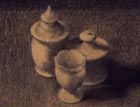John Sergeant
John Sergeant is one of Britain's most respected living masters in the art of drawing. His latest still lifes exemplify his passion for the object and ability to have 'one foot in the past and one in the present.' Anna Tyzack goes to meet him


'When I was seventeen I hated still life,' says John Sergeant, one of Britain's most celebrated authorities in the art of drawing. 'I thought it was the dullest, dreariest thing one could ever do.' Mr Sergeant's latest exhibition at Colnaghi, Old Bond St proves he has changed his mind. The collection of 35 exquisite still lifes is full of movement and light. The charcoal drawings present mouth-watering apples, soft leather shoes, and gleaming metal buttons and, unsurprisingly, many of the works brandished red stickers after the private view.
Although Mr Sergeant always wanted to be an artist, depicting household objects was not his initial priority - interior paintings were his first love. But it was through executing interior commissions that he became aware of his growing fascination with the object. 'I've always loved junk shops,' he explains. 'Generally I like modest, shapely objects - I love to make something special out of something ordinary.' But Mr Sergeant is at pains to point out that his work is not contrived. His love of the object, he says, is a little like preferring blonds to brunettes - there is no rhyme or reason to it. 'I sometimes think that objects choose me.'
The works of eighteenth century French still life master Jean-Siméon Chardin are one of Mr Sergeant's biggest inspirations - shining surfaces, masterful compositions and intricate detail. But the simplicity and painterly fluidity of Morandi's still lifes can also be seen in his drawings and he is fascinated by the small, dark early Spanish still lifes. 'I think it is the Spanish blood is me coming out?' he admits. His work does not shy away from lettering or negative space: 'My drawings can be taken at different levels - they can be seen as objects or as flat patterns. The strength of the piece lies in between the pattern, in the negative space.' In this respect, he compares his work to that of Ben Nicholson, a modern abstract painter who, according to Mr Sergeant is 'hugely accomplished at devising a composition.'
'My priority is to turn the subject into a pattern,' Mr Sergeant writes in the exhibition catalogue, 'At the same time the viewer must be able to turn that pattern back into a pair of shoes, a box of buttons, or whatever it is I have drawn.'
But Nicholson is one of the few modern artists to win Mr Sergeant's favour. 'I do have a problem with a lot of modern art,' he admits. His 1950s art school education is something he holds close to his heart, claiming that a couple of year after he left, 'the whole thing became ridiculous': 'I was one of the last to squeeze through the old system,' he says. 'I am a great believer in training - in knowing your craft, your skill. That is how I discovered what I could do best.' Art schools in 2006 disappoint him bitterly. 'I think they should all be burned,' he says with alarming candour. When asked to expand he reveals a sincere dissatisfaction with the 'materialistic' nature of British art schools. Even the more traditional establishments fail to live up to his ideals, 'They are unhealthy and sterile,' he explains, 'Art is no longer based on knowledge and feeling but on a set of rules.'
Mr Sergeant built up his career slowly: commissions put bread on the table during his first years as a practicing artist but he was aware of their restrictions: 'Commissions can be very compromising. I've worked hard to get to a position where I no longer have to do them. I now make a living doing what I love.' And Mr. Sergeant, now aged 67, can be very proud of what he has achieved.
And his condemnation of British art schools is by no means empty criticism- he is at pains to point out that he would love to have the opportunity to change things - to give someone else the opportunities he had. He explains how the support and encouragement of John Ward - whose meticulous drawings are still celebrated posthumously - helped forge his first steps as an artist: 'I'd left two drawings at the house of a girlfriend while I went and did military service,' he says, 'And John Ward saw them and immediately got in touch.' Mr. Sergeant became his protégé, taking on his unwanted commissions and sharing his contacts. The following year, 1959, he entered the Royal Academy School, winning the Drawing Prize in his final year in 1962.
Sign up for the Country Life Newsletter
Exquisite houses, the beauty of Nature, and how to get the most from your life, straight to your inbox.
'I'm longing to find someone to pass my knowledge onto,' he says, 'And with a country this size, there has got to be a Michaelangelo somewhere.'
John Sergeant's most recent drawings are on display until Tuesday March 21 2006 in the Colnaghi Gallery, 15 Old Bond St, London. For more information or to request a catalogue please telephone +44 (0)207 491 7408.
Country Life is unlike any other magazine: the only glossy weekly on the newsstand and the only magazine that has been guest-edited by HRH The King not once, but twice. It is a celebration of modern rural life and all its diverse joys and pleasures — that was first published in Queen Victoria's Diamond Jubilee year. Our eclectic mixture of witty and informative content — from the most up-to-date property news and commentary and a coveted glimpse inside some of the UK's best houses and gardens, to gardening, the arts and interior design, written by experts in their field — still cannot be found in print or online, anywhere else.
-
 From California to Cornwall: How surfing became a cornerstone of Cornish culture
From California to Cornwall: How surfing became a cornerstone of Cornish cultureA new exhibition at Cornwall's National Maritime Museum celebrates a century of surf culture and reveals how the country became a global leader in surf innovation and conservation.
By Emma Lavelle Published
-
 Jaecoo 7 SHS: Can you really get a luxury SUV for £35,000?
Jaecoo 7 SHS: Can you really get a luxury SUV for £35,000?The Chinese automaker Jaecoo lands on UK shores with the 7. We take it for a spin around Scotland and the north of England to see if the hype is real.
By Charlie Thomas Published
